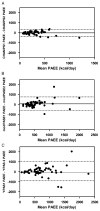Comparative validity of physical activity measures in older adults
- PMID: 20881882
- PMCID: PMC3303696
- DOI: 10.1249/MSS.0b013e3181fc7162
Comparative validity of physical activity measures in older adults
Abstract
Purpose: To compare the validity of various physical activity measures with doubly labeled water (DLW)-measured physical activity energy expenditure (PAEE) in free-living older adults.
Methods: Fifty-six adults aged ≥65 yr wore three activity monitors (New Lifestyles pedometer, ActiGraph accelerometer, and a SenseWear (SW) armband) during a 10-d free-living period and completed three different surveys (Yale Physical Activity Survey (YPAS), Community Health Activities Model Program for Seniors (CHAMPS), and a modified Physical Activity Scale for the Elderly (modPASE)). Total energy expenditure was measured using DLW, resting metabolic rate was measured with indirect calorimetry, the thermic effect of food was estimated, and from these, estimates of PAEE were calculated. The degree of linear association between the various measures and PAEE was assessed, as were differences in group PAEE, when estimable by a given measure.
Results: All three monitors were significantly correlated with PAEE (r=0.48-0.60, P<0.001). Of the questionnaires, only CHAMPS was significantly correlated with PAEE (r=0.28, P=0.04). Statistical comparison of the correlations suggested that the monitors were superior to YPAS and modPASE. Mean squared errors for all correlations were high, and the median PAEE from the different tools was significantly different from DLW for all but the YPAS and regression-estimated PAEE from the ActiGraph.
Conclusions: Objective devices more appropriately rank PAEE than self-reported instruments in older adults, but absolute estimates of PAEE are not accurate. Given the cost differential and ease of use, pedometers seem most useful in this population when ranking by physical activity level is adequate.
© 2011 by the American College of Sports Medicine
Conflict of interest statement
The authors report no conflicts of interest.
Figures



Similar articles
-
Physical Activity Assessment with the ActiGraph GT3X and Doubly Labeled Water.Med Sci Sports Exerc. 2017 Sep;49(9):1935-1944. doi: 10.1249/MSS.0000000000001299. Med Sci Sports Exerc. 2017. PMID: 28419028 Free PMC article.
-
Accuracy of 12 Wearable Devices for Estimating Physical Activity Energy Expenditure Using a Metabolic Chamber and the Doubly Labeled Water Method: Validation Study.JMIR Mhealth Uhealth. 2019 Aug 2;7(8):e13938. doi: 10.2196/13938. JMIR Mhealth Uhealth. 2019. PMID: 31376273 Free PMC article.
-
Comparison of methods to assess energy expenditure and physical activity in people with spinal cord injury.J Spinal Cord Med. 2012 Jan;35(1):35-45. doi: 10.1179/2045772311Y.0000000046. J Spinal Cord Med. 2012. PMID: 22330189 Free PMC article.
-
Usefulness of motion sensors to estimate energy expenditure in children and adults: a narrative review of studies using DLW.Eur J Clin Nutr. 2017 Mar;71(3):331-339. doi: 10.1038/ejcn.2017.2. Epub 2017 Feb 1. Eur J Clin Nutr. 2017. PMID: 28145419 Review.
-
Assessment of Physical Activity in Adults: A Review of Validated Questionnaires From a Nutritionist's Point of View.Eval Health Prof. 2020 Dec;43(4):235-254. doi: 10.1177/0163278720928500. Epub 2020 Jun 22. Eval Health Prof. 2020. PMID: 32567363 Review.
Cited by
-
Associations between physical function and device-based measures of physical activity and sedentary behavior patterns in older adults: moving beyond moderate-to-vigorous intensity physical activity.BMC Geriatr. 2021 Mar 31;21(1):216. doi: 10.1186/s12877-021-02163-4. BMC Geriatr. 2021. PMID: 33789584 Free PMC article.
-
Impact of Nutritional Intake on Function in People with Mild-to-Moderate Multiple Sclerosis.Int J MS Care. 2019 Jan-Feb;21(1):1-9. doi: 10.7224/1537-2073.2017-039. Int J MS Care. 2019. PMID: 30833865 Free PMC article.
-
Step detection and activity recognition accuracy of seven physical activity monitors.PLoS One. 2015 Mar 19;10(3):e0118723. doi: 10.1371/journal.pone.0118723. eCollection 2015. PLoS One. 2015. PMID: 25789630 Free PMC article.
-
Factors associated with physical activity of women aged over 75 in South Korea.J Exerc Rehabil. 2018 Jun 30;14(3):387-393. doi: 10.12965/jer.1836228.114. eCollection 2018 Jun. J Exerc Rehabil. 2018. PMID: 30018923 Free PMC article.
-
The association between Geographic Information System-based neighborhood built environmental factors and accelerometer-derived light-intensity physical activity across the lifespan: a cross-sectional study.PeerJ. 2022 Apr 8;10:e13271. doi: 10.7717/peerj.13271. eCollection 2022. PeerJ. 2022. PMID: 35419214 Free PMC article.
References
-
- Ainsworth B, Haskell W, Leon A, et al. Compendium of physical activities: classification of energy costs of human physical activities. Med Sci Sports Exerc. 1993;25(1):71–80. - PubMed
-
- Berntsen S, Hageberg R, Aandstad A, et al. Validity of physical activity monitors in adults participating in free living activities. Br J Sports Med. 2010;44:657–64. - PubMed
-
- Bonnefoy M, Normand S, Pachiaudi C, Lacour J, Laville M, Kostka T. Simultaneous validation of ten physical activity questionnaires in older men: a doubly labeled water study. J Am Geriatr Soc. 2001;49:28–35. - PubMed
-
- Choquette S, Chuin A, Lalancette D, Brochu M, Dionne I. Predicting energy expenditure in elders with the metabolic cost of activities. Med Sci Sports Exerc. 2009;41(10):1915–20. - PubMed
-
- Cole T, Coward W. Precision and accuracy of doubly labeled water energy expenditure by multipoint and two-point methods. Am J Physiol. 1992;263:E965–73. - PubMed
Publication types
MeSH terms
Grants and funding
LinkOut - more resources
Full Text Sources

